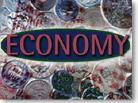|
Greenspan: Outlook weaker
|
 |
October 7, 1998: 3:33 p.m. ET
Fed Chairman says Asian contagion far from over, U.S. economy still stable
|
NEW YORK (CNNfn) - Federal Reserve Chairman Alan Greenspan said Wednesday the outlook for the U.S. economy has weakened "measurably" as the economic crisis in Russia and Asian drags on. But, he added, the domestic economy remains alive and well for the time being.
Speaking before the National Association for Business Economics, Greenspan also said that the markets have developed a dramatic aversion to risk since Russia placed a moratorium on the repayment of its debt in August, causing investors to flock to more liquid investments, such as U.S. Treasurys.
And despite rumblings to the contrary, he said the economy is nowhere near experiencing a credit crunch.
Greenspan said the same thing, however, at the beginning of the credit crunch in the early 1980s.
"It's pretty obvious, I think, that the outlook for 1999 for the U.S. economy has weakened measurably in the aftermath of Russian devaluation and debt moratorium," he said.
No deja vu in sight
Greenspan noted that the phenomenon of market conditions surrounding the U.S. today is unlike anything he's seen before.
"I've never seen anything like this," he said. "This is really quite an unusual phenomenon."
In reading economic reports, he said, "one gets the impression that the economy has collapsed and we might as well all go home and go fishing or something, but the truth is that we are still seeing fairly significant continued momentum occurring as a consequence of previous major expansion in the wealth effect and (a variety of other economic factors)."
Greenspan noted that in the current risk-averse environment, the United States is beginning to see anecdotal evidence that capital investment projects are being scaled back and non-defense durable goods orders are flattening, not shrinking.
Risk aversion, he said, also is showing up in the stock market downturn and the increase of equity premiums and cost of capital.
Earlier suggestions that the so-called Asian contagion has moved into remission "have been proven quite wrong," he said.
Another rate cut soon?
Analysts read Greenspan's remarks as indicating the Fed's readiness to continue cutting rates to both prevent an economic crash and boost liquidity levels in jittery capital markets.
The Fed last week cut its key short-term interest rate by a modest quarter-percentage point to 5.25 percent to cushion the effects of a global financial crisis on the U.S. economy. But many in financial markets deemed the cut insufficient to fend off the economic slump that has hurt many parts of the world.
"He's certainly opened the door to another rate cut," said Diane Swonk, economist at First Chicago NBD, after listening to the speech, adding that the Fed would need to monitor events as they evolve and react to them as warranted.
The Fed next meets to debate interest rates on Nov. 17, but some Fed watchers read Greenspan's forthright speech as opening the door to a possible rate move even before that meeting -- a highly unusual step which the Fed has not taken since 1994.
John Silvia, chief economist at Scudder Kemper Investments Inc. in Chicago, said such a move could not be ruled out.
"What he's telling us is that we don't know what it is going to take to keep the economy moving ahead. Because of all these unknowns, there's a lot more of a possibility of an inter-meeting move," he said.
Flight to safety overdone?
Analysts also indicated Greenspan's comments on next year's economic outlook came as no surprise. But they say he might be hinting that the investor flight to the relative safety of U.S. Treasury bonds may be "overdone."
"I think he basically said, reading between the lines, that he thought maybe the flight to quality was a little bit overdone and that maybe on-the-run Treasury yields have gotten ahead of themselves," said Bill Hornbarger, an analyst with A.G. Edwards.
The benchmark 30-year Treasury bond Wednesday afternoon was down 1-16/32 for a yield of 4.82 percent. Two days earlier, the yield hit a record low of 4.72 percent.
Russia affects risk tolerance
Lastly, Greenspan said the economic crisis plaguing Russia has had little direct impact on U.S. markets, but it did become the catalyst for a sea change in the risk-tolerance levels of investors. In August, the Russian government placed a 90-day moratorium on the repayment of international debt in efforts to keep its beleaguered currency reserves afloat.
"Clearly the size of the Russian economy, either in real terms or in financial terms, can scarcely be an element which would engender the types of consequences that have occurred subsequent to that moratorium, so what we are looking at is a far more fundamental shift in attitudes, with the Russian episode as the triggering mechanism," he said. 
-- from staff and wire reports
|
|
|
|
|
 |

|

